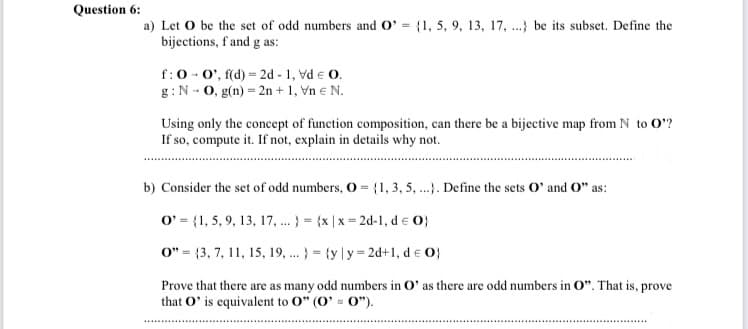Question 6: a) Let O be the set of odd numbers and O' (1, 5, 9, 13, 17, ..) be its subset. Define the bijections, f'and g as: f:0 - 0', f(d) 2d - 1, vd e O. g: N - 0, g(n) - 2n + 1, Vn e N. Using only the concept of function composition, can there be a bijective map from N to O"? If so, compute it. If not, explain in details why not. b) Consider the set of odd numbers, O= (1, 3, 5, .. Define the sets O' and O" as: O' = {1, 5, 9, 13, 17, .. } (x |x 2d-1, de O} 0" = (3, 7, 11, 15, 19, .} ty |y 2d+1, d e O} Prove that there are as many odd numbers in O' as there are odd numbers in O", That is, prove that O' is equivalent to O" (0' 0").
Question 6: a) Let O be the set of odd numbers and O' (1, 5, 9, 13, 17, ..) be its subset. Define the bijections, f'and g as: f:0 - 0', f(d) 2d - 1, vd e O. g: N - 0, g(n) - 2n + 1, Vn e N. Using only the concept of function composition, can there be a bijective map from N to O"? If so, compute it. If not, explain in details why not. b) Consider the set of odd numbers, O= (1, 3, 5, .. Define the sets O' and O" as: O' = {1, 5, 9, 13, 17, .. } (x |x 2d-1, de O} 0" = (3, 7, 11, 15, 19, .} ty |y 2d+1, d e O} Prove that there are as many odd numbers in O' as there are odd numbers in O", That is, prove that O' is equivalent to O" (0' 0").
Algebra & Trigonometry with Analytic Geometry
13th Edition
ISBN:9781133382119
Author:Swokowski
Publisher:Swokowski
Chapter5: Inverse, Exponential, And Logarithmic Functions
Section5.1: Inverse Functions
Problem 18E
Related questions
Question
100%

Transcribed Image Text:Question 6:
a) Let O be the set of odd numbers and O' = {1, 5, 9, 13, 17, .} be its subset. Define the
bijections, f'and g as:
f:0 - 0', f(d) = 2d - 1, vd e O.
g:N - 0, g(n) = 2n + 1, Vn e N.
Using only the concept of function composition, can there be a bijective map from N to O?
If so, compute it. If not, explain in details why not.
b) Consider the set of odd numbers, O = {1, 3, 5 .). Define the sets O' and O" as:
O' = {1, 5, 9, 13, 17, . } = {x | x = 2d-1, de 0}
0" = {3, 7, 11, 15, 19, .. } = {y |y = 2d+1, d e O}
Prove that there are as many odd numbers in O' as there are odd numbers in O". That is, prove
that O' is equivalent to O" (0' = 0").
Expert Solution
This question has been solved!
Explore an expertly crafted, step-by-step solution for a thorough understanding of key concepts.
This is a popular solution!
Trending now
This is a popular solution!
Step by step
Solved in 2 steps

Knowledge Booster
Learn more about
Need a deep-dive on the concept behind this application? Look no further. Learn more about this topic, advanced-math and related others by exploring similar questions and additional content below.Recommended textbooks for you

Algebra & Trigonometry with Analytic Geometry
Algebra
ISBN:
9781133382119
Author:
Swokowski
Publisher:
Cengage

Elements Of Modern Algebra
Algebra
ISBN:
9781285463230
Author:
Gilbert, Linda, Jimmie
Publisher:
Cengage Learning,


Algebra & Trigonometry with Analytic Geometry
Algebra
ISBN:
9781133382119
Author:
Swokowski
Publisher:
Cengage

Elements Of Modern Algebra
Algebra
ISBN:
9781285463230
Author:
Gilbert, Linda, Jimmie
Publisher:
Cengage Learning,


Linear Algebra: A Modern Introduction
Algebra
ISBN:
9781285463247
Author:
David Poole
Publisher:
Cengage Learning